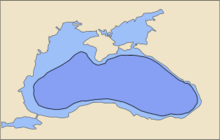Inundación del mar Negro , la enciclopedia libre

La inundación del mar Negro es la hipótesis científica que supone el desbordamiento del antiguo mar Mediterráneo sobre el antiguo mar interior que ocupaba el actual espacio del mar Negro, abriéndose el actual estrecho del Bósforo. Habría tenido lugar hacia el 5600 a. C., y presumiblemente habría tenido importantes repercusiones sobre la protohistoria del Antiguo Oriente Próximo y el Mediterráneo oriental, incluso pudo haber estado en el origen del relato bíblico del diluvio universal.
Hipótesis
[editar]La hipótesis fue formulada por William Ryan y Walter Pitman, quienes en diciembre de 1996 la divulgaron a través de un artículo en The New York Times,[1] poco antes de publicarlo en Marine Geology.[2]
Aunque la secuencia de hechos que los autores describen están asumidos por la comunidad científica, hay un debate sobre su condición catastrófica (magnitud y celeridad —supuestamente, el hecho se habría producido en el transcurso de unas pocas semanas—), así como en su datación. Se han propuesto dos hipótesis alternativas: una gradualista y otra cíclica.[3] Esta última especifica que en los últimos treinta mil años se han producido intermitentemente aislamientos y contactos entre el mar Negro y el Egeo a una escala de magnitud relativamente pequeña, sin necesidad de acontecimientos catastróficos que «rellenaran» la cuenca.
Una expedición llevada a cabo en 1999 por el investigador submarino Robert Ballard recogió muestras de moluscos de agua dulce y de otras pruebas de la existencia de una línea costera del supuesto mar interior, actualmente bajo la superficie del mar Negro.[4] Ballard seguía investigando en la zona en 2012.[5]
Véase también
[editar]- Inundación zancliense o inundación del Mediterráneo por la apertura del estrecho de Gibraltar (periodo Zancliense, hace 5 millones de años).
Notas
[editar]- ↑ Wilford, John Noble (17 de diciembre de 1996). «Geologists Link Black Sea Deluge To Farming's Rise». The New York Times. Consultado el 17 de junio de 2013.
- ↑ Ryan and Pitman 1997.
- ↑ Yanko-Hombach et al. 2007
- ↑ Educaixa
- ↑ ABC News
Bibliografía
[editar]Fuentes
[editar]- Aksu, Ali E. et al. 2002. Persistent Holocene Outflow from the Black Sea to the Eastern Mediterranean Contradicts Noah's Flood Hypothesis. GSA Today, May 2002, 12(5): 4–10. doi <0004:PHOFTB>2.0.CO;2 10.1130/1052-5173(2002)012<0004:PHOFTB>2.0.CO;2
- Sperling, M., Schmiedl, G., Hemleben, C., Emeis, K. C., Erlenkeuser, H., and Grootes, P. M. 2003. Black Sea impact on the formation of eastern Mediterranean sapropel S1? Evidence from the Marmara Sea. Palaeogeography, Palaeoclimatology, Palaeoecology 190, 9-21.
- Gökaşan, E., Algan, O., Tur, H., Meriç, E., Türker, A., and Şimşek, M. 2005. Delta formation at the southern entrance of Istanbul Strait (Marmara sea, Turkey): a new interpretation based on high-resolution seismic stratigraphy. Geo-Marine Letters 25, 370-377.
- Eris, K., Ryan, W. B. F., Cagatay, N., Sancar, Ü., Lericolais, G., Menot, G., and Bard, E. 2008.The timing and evolution of the post-glacial transgression across the Sea of Marmara shelf south of İstanbul. Marine Geology 243, 57-76.
- Dimitrov, Petko and Dimitrov, Dimitar. 2004. The Black Sea, the flood, and the ancient myths. Varna (Bulgaria): Slavena.
- Keith, M.L. and Anderson, G.M. 1963. Radiocarbon Dating: Fictitious Results with Mollusk Shells. Science, 1963 August 13, 141(3581): 634–637. doi 10.1126/science.141.3581.634
- National Geographic News. 2009-02-06. "Noah's Flood" Not Rooted in Reality, After All?
- Nature. 2004 August 12. Noah's Flood. 430: 718-19
- New Scientist. 2004 May 4. Flood hypothesis seems to hold no water. 2341: 13
- Ryan, W.B.F.; Pitman III, W.C., et al. 1997. An abrupt drowning of the Black Sea shelf. Marine Geology, 138: 119–126.
- Yanko-Hombach, Valentina. 2007. The Black Sea Flood Question: Changes in Coastline, Climate and Human Settlement. Springer ISBN 1-4020-4774-6.
- Chepalyga A.L. The late glacial Great Flood in the Ponto-Caspian basin. In: The Black Sea Flood question: changes in coastline, climate and human settlement. Springer. 2006. pp. 119–148 [1] (enlace roto disponible en Internet Archive; véase el historial, la primera versión y la última).
Bibliografía complementaria
[editar]- Giosan, Liviu et al. 2009. Was the Black Sea catastrophically flooded in the early Holocene? Quaternary Science Reviews, January 2009, 28(12-2): 1-6. doi 10.1016/j.quascirev.2008.10.012
This article (possibly not identical to the preceding citation) is available online with unrestricted access here at the sponsoring institution's website. - Noah's Not-so-big Flood
- Lericolais, G. [2] et al. 2009. High frequency sea level fluctuations recorded in the Black Sea since the LGM. Global and Planetary Change, March 2009, 66(1-2): 65-75
- "Ballard and the Black Sea"
- Ryan, William B.; Pitman, Walter C. (2000), Noah's Flood: The new scientific discoveries about the event that changed history, Simon & Schuster, ISBN 0-684-85920-3.
- Dimitrov, D. 2010. Geology and Non-traditional resources of the Black Sea. LAP Lambert Academic Publishing. ISBN 978-3-8383-8639-3. 244p.
- The late glacial Great Flood in the Ponto-Caspian basin
- Yanko-Hombach, Valentina (8 de diciembre de 2006), Allan S. Gilbert, Nicolae Panin and Pavel M. Dolukhanov, ed., The Black Sea Flood Question, Springer, p. 999, ISBN 978-1-4020-4774-9.
- Shopov Y. Y., Т. Yalamov, P. Dimitrov, D. Dimitrov and B. Shkodrov (2009b) Initiation of the Migration of Vedic Aryans to India by a Catastrophic Flooding of the Black Sea by Mediterranean Sea during the Holocene.” Extended Abstracts of LIMPACS-3 International Conference of IGBP, PAGES, 5-8 March 2009, Chandigarh, India, pp.126-127.


 French
French Deutsch
Deutsch